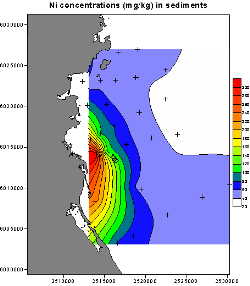Tracing Sediment from the mountains to the Bay
13/03/2009 |
| Spatial distributions of Ni concentrations in weak–acid digested marine sediments of Tasman Bay |
The March 2005 flood that was centred in the upper Motueka River catchment eroded significant amounts of sediment from a mineral belt region known as the Red Hills. These sediments were flushed into and through the main stem of the Motueka River with considerable amounts finding their way out into Tasman Bay. By investigating the concentrations of these metals in River margin sediments, Reid Forrest and Paul Gillespie were able to show that the flood moved sediments from the Red Hills into and through the main stem of the River. The relative proportion of the various metals in Tasman Bay sediments provided a useful ‘signature’ for identifying the spatial extent of the influence of the Motueka River plume in the coastal environment.
River margin sediments from the Motueka gorge were over 20 times greater than recommended ANZECC (2000) guideline levels suggesting “probable biological effects”. Although they became progressively more dilute further downstream as they were mixed with sediments from other parts of the catchment, they were still above guideline levels in the lower reaches of River. Metal concentrations of sediments from tributary streams were all found to be well below guideline levels.
Marine sediments were collected from a network of 24 stations in western Tasman Bay and analysed for a suite of 10metals using the University of Otago’s new ICP–MS facility. Results showed that the influence of the river plume extended out to around 7 km offshore from the river mouth. The detectable sedimentation footprint covered an area of about 80 km2 with plume–affected nickel concentrations up to 7 times higher than background levels in other regions of the Bay. Macrofauna assemblages at the sites with the highest metal levels contained fewer species but greater abundances of opportunistic, disturbance tolerant species such as Theora lubrica and the capitellid polychaete worm, Heteromastus filiformis. The changes in infauna community structure were found to correlate significantly with increased Ni, Cu and Cr levels in the sediments.
Towards the end of the river plume sampling programme, a medium sized flood event occurred in the Motueka River. Although the rainfall was not centred in the Red Hills area as in 2005, post–flood samples of marine sediments near the River mouth (taken in the same locations as pre–flood samples) showed significantly increased levels of Ni and Cr. This suggested that metals–enriched sediments remaining in the River from previous flood events focused in the upper catchment are still being flushed out into Tasman Bay as pulse events during elevated river flows.
The boundary of the area of elevated sediment metal concentrations lies just inside existing spat collecting, and proposed mussel farming areas in Tasman Bay. Considering that, following large floods, fine suspended sediments containing elevated levels of metals could be circulated into these areas; future research will need to investigate potential impacts on cultured and wild shellfish stocks.
Key Contact:

|
Reid Forrest
Email Cawthron Institute Phone: 035482319 |
Expertise Sediment geochemistry |